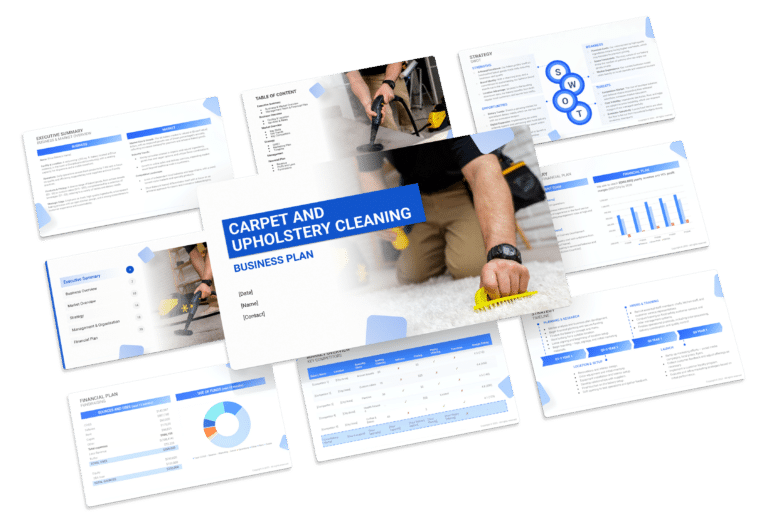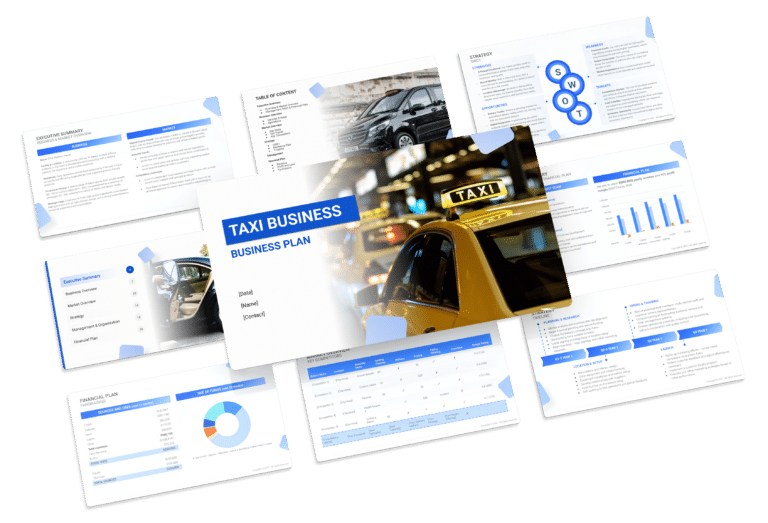Landscaping Business Plan Template & PDF Example
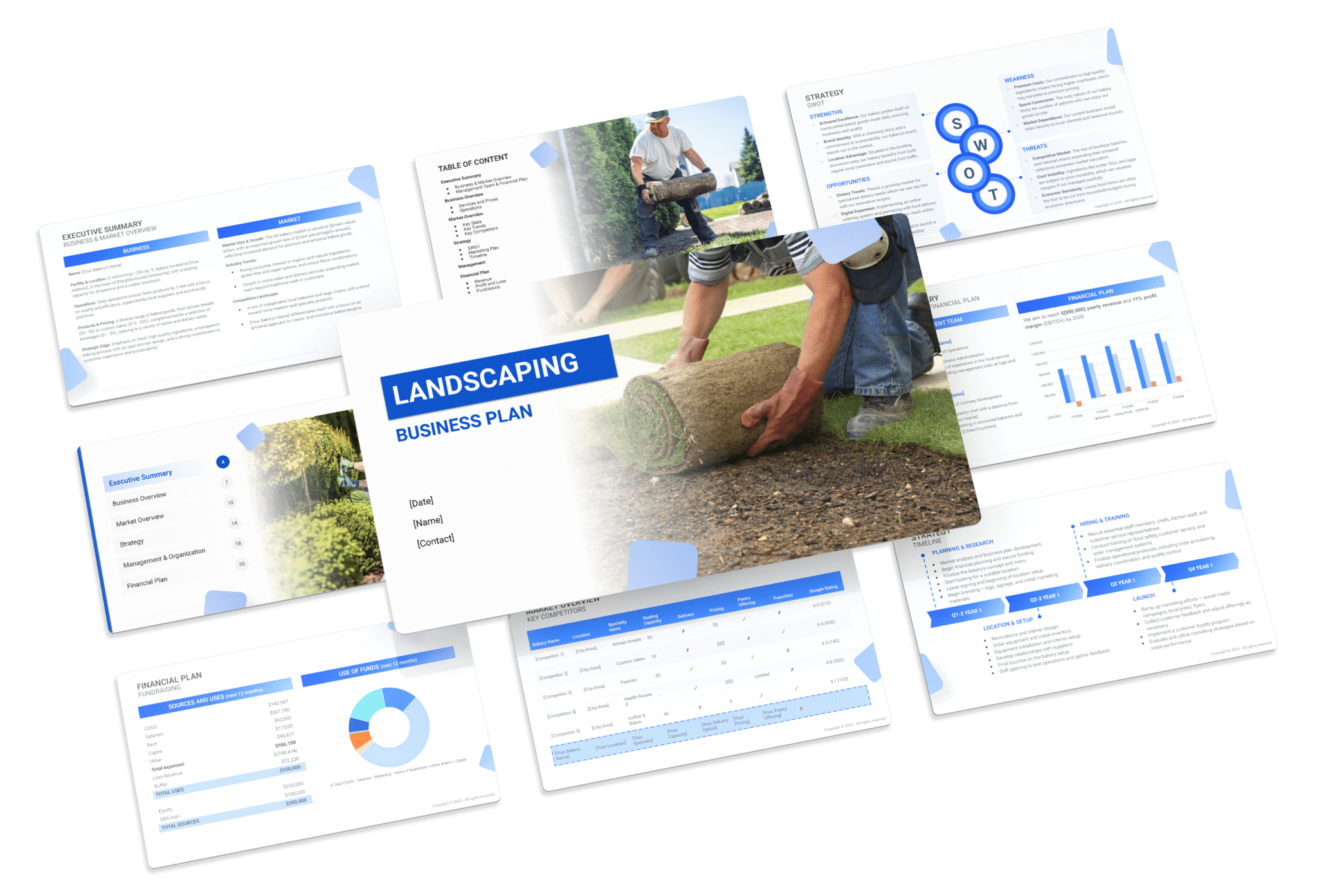
Creating a comprehensive business plan is crucial for launching and running a successful landscaping business. This plan serves as your roadmap, detailing your vision, operational strategies, and financial plan. It helps establish your landscaping business’s identity, navigate the competitive market, and secure funding for growth.
This article not only breaks down the critical components of a landscaping business plan, but also provides an example of a business plan to help you craft your own.
Whether you’re an experienced entrepreneur or new to the service industry, this guide, complete with a business plan example, lays the groundwork for turning your landscaping business concept into reality. Let’s dive in!
The Plan
Our landscaping business plan is designed to encompass all critical components necessary for a holistic strategic approach. It outlines the company’s service offerings, marketing efforts, analysis of the market and competitors, organizational structure, and financial forecasts.
- Executive Summary: Offers an overview of your landscaping business concept, market analysis, management, and financial strategy.
- Business Overview: Provides detailed information on your landscaping service and its operational model:
- Services and Rates: Lists the range of landscaping services offered, such as landscape design, lawn care, hardscaping, irrigation systems, and seasonal maintenance, with a clear pricing structure.
- Market Overview: Examines the landscaping industry landscape, identifying competitors and how your service stands out:
- Key Stats: Shares industry size, growth trends, and relevant statistics for the landscaping market.
- Key Trends: Highlights recent trends in the landscaping industry, such as the emphasis on sustainable and eco-friendly practices and technological advancements in landscaping tools.
- Key Competitors: Analyzes main competitors in your area and differentiates your service in terms of design creativity, service range, and environmental sustainability.
- Strategy: Outlines how the landscaping service plans to achieve growth and attract clients:
- SWOT: Strengths, weaknesses, opportunities, and threats analysis tailored to your landscaping business.
- Marketing Plan: Specifies marketing strategies to promote your services, including digital advertising, local trade shows, and partnerships with local suppliers.
- Timeline: Key milestones and objectives from the initial setup to the first year of operations, detailing steps such as market analysis, legal setup, facility selection, equipment procurement, and launch marketing activities.
- Management: Information on the management team, highlighting their expertise in landscaping design, operations management, project execution, and client relationship management.
- Financial Plan: Projects the five-year financial performance of the landscaping service, including revenue targets, profit and loss statements, fundraising needs, cash flow projections, and balance sheet forecasts.

Executive Summary
The Executive Summary introduces your landscaping business plan, offering a concise overview of your company and its services. It should detail your market positioning, the range of landscaping and garden care services you offer, its location, size, and an outline of day-to-day operations.
This section should also explore how your landscaping business will integrate into the local market, including the number of direct competitors within the area, identifying who they are, along with your company’s unique selling points that differentiate it from these competitors.
Furthermore, you should include information about the management and co-founding team, detailing their roles and contributions to the company’s success. Additionally, a summary of your financial projections, including revenue and profits over the next five years, should be presented here to provide a clear picture of your company’s financial plan.
Landscaping Business Plan Executive Summary Example

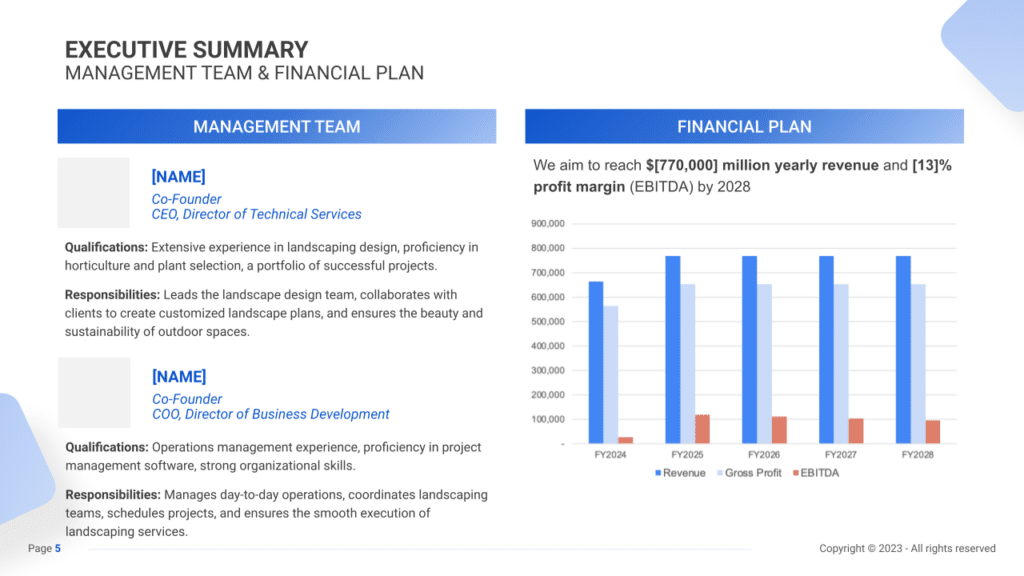
Business Overview
In introducing your landscaping business within the executive summary, it is imperative to offer a clear snapshot. This encompasses the business name, geographical location, and an overview of daily operations.
Example:
“GreenScape Innovations,” positioned strategically in [City Name], caters to a [x]-mile radius, providing an array of landscaping services including garden design, lawn care, hardscaping, irrigation systems, and seasonal maintenance. The distinguishing factor lies in the company’s commitment to infusing creativity into designs and prioritizing sustainability, resulting in outdoor spaces that are both aesthetically pleasing and eco-conscious.
Market Overview
Understanding the market dynamics is pivotal. It involves showcasing the market size, growth trajectories, and industry nuances to provide an understanding of the landscape in which your business operates.
Example:
The landscaping industry stands as a robust sector valued at approximately $176.5 billion, exhibiting a promising growth trajectory with an anticipated Compound Annual Growth Rate (CAGR) of +7.3% from 2023 to 2030. Within this expansive market, a diverse array of businesses, ranging from small, local operators to large, national service providers, compete for market share. Within our operating radius, we have identified [5] key competitors, each contributing to the local landscape services within a [x]–mile reach.
Management Team
The prowess and expertise of the managerial team constitute a critical asset. Illuminating their backgrounds and experiences fosters credibility and confidence among potential stakeholders.
Example:
The team at GreenScape Innovations boasts extensive experience in landscaping design, horticulture, and a proven track record of successful projects. Their collaboration with clients ensures customized landscape plans that seamlessly blend beauty with sustainability.
The operational management team, equipped with substantial experience in operations and project management, ensures the seamless execution of services. Their adept coordination and project scheduling guarantee efficient and effective delivery of landscaping services.
Financial Plan
A concise overview of the financial plan outlines the business’s revenue targets, growth projections, and key strategies for achieving financial success.
Example:
GreenScape Innovations aims to achieve an annual revenue milestone of $770,000 million, accompanied by a targeted profit margin (EBITDA) of [13]% by 2028.
This strategic financial trajectory aligns with our commitment to innovation, sustainable practices, and customer-centric services. It involves a comprehensive approach encompassing investment in cutting-edge technology, training, and strategic alliances to facilitate revenue growth while ensuring operational excellence.
Business Overview
Services and Rates
Detail the range of landscaping services offered, from routine lawn maintenance and garden care to specialized services like landscape design, hardscaping, or irrigation system installation.
Outline your pricing strategy, ensuring it reflects the quality of services provided and aligns with the market you’re targeting. Highlight any service packages, seasonal deals, or loyalty programs that provide added value to your clients, encouraging repeat business and fostering customer loyalty.

Market Overview

Industry size & growth
In the Market Overview of your landscaping business plan, start by examining the size of the landscaping industry and its growth potential. This analysis is crucial for understanding the market’s scope and identifying expansion opportunities.
Consider factors such as the increase in residential and commercial development, the growing emphasis on outdoor living spaces, and the rising awareness of the environmental benefits of well-maintained landscapes.
Key market trends
Proceed to discuss recent market trends, such as the increasing consumer interest in sustainable and eco-friendly landscaping practices, the demand for outdoor living spaces equipped with features like fire pits, outdoor kitchens, and entertainment areas, and the growing popularity of native plant gardens that require less water and maintenance.
Highlight the demand for services that cater to specific landscape design and maintenance needs, alongside the rising popularity of smart irrigation systems to conserve water.
Competitive Landscape
A competitive analysis is not just a tool for gauging the position of your landscaping business in the market and its key competitors; it’s also a fundamental component of your business plan.
This analysis helps in identifying your landscaping business’s unique selling points, essential for differentiating your business in a competitive market.
In addition, competitive analysis is integral to laying a solid foundation for your business plan. By examining various operational aspects of your competitors, you gain valuable information that ensures your business plan is robust, informed, and tailored to succeed in the current market environment.
Identifying Your Competitors in the Landscaping Industry
The first step in conducting a competitive analysis for a landscaping business involves identifying direct and indirect competitors. Direct competitors are other landscaping companies offering similar services in your area. These could range from small, local landscaping firms to larger, established companies with a regional presence. Indirect competitors might include lawn maintenance services, gardening centers, or even DIY solutions.
Utilize online resources and local directories to compile a list of competitors. Additionally, review customer testimonials and ratings on platforms like Google, Yelp, or Angie’s List to gain insights into their strengths and weaknesses. For instance, if a competitor like “Green Thumb Landscapes” receives consistent praise for their eco-friendly designs, this reflects a potential strength to consider.
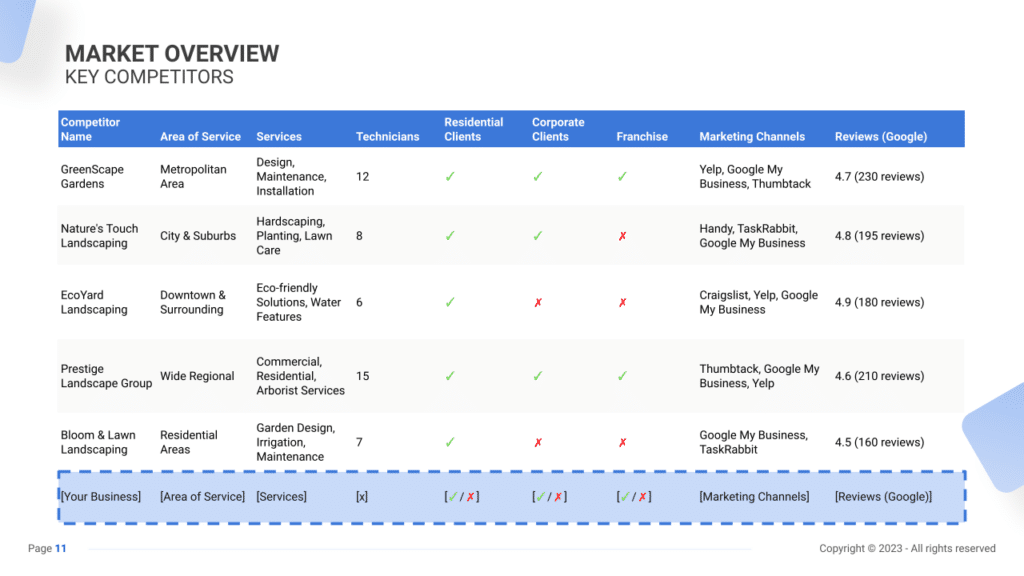
Landscaping Competitors’ Strategies
Analyzing competitors’ strategies involves assessing various facets of their business:
- Service Offerings: Examine the range of services your competitors provide. Are there companies specializing in particular niches like sustainable landscaping, hardscaping, or garden design?
- Approach and Expertise: Consider the approaches and expertise your competitors showcase. For instance, a company known for using innovative technologies in irrigation systems might differentiate itself from others focusing solely on traditional landscaping methods.
- Pricing and Packages: Compare pricing structures and service packages offered by competitors. Are there firms catering to high-end clients with premium landscape design services, while others target affordability with basic lawn care packages?
- Marketing and Branding: Analyze competitors’ marketing strategies. Do they leverage social media effectively, maintain informative blogs, or engage in community events? Understanding their branding efforts helps shape your own marketing strategies.
- Client Relationships: Evaluate how competitors build and maintain relationships with clients. Companies offering personalized consultations or regular maintenance plans might have an edge in customer retention.
- Operational Efficiency: Look for signs of innovation or efficiency in their operations. For example, companies employing eco-friendly practices or utilizing advanced software for project management indicate a commitment to efficiency and sustainability.
What’s Your Landscaping Business’s Unique Selling Proposition?
Identify your landscaping business’s unique value proposition that sets it apart. Perhaps your company specializes in drought-resistant landscaping or offers comprehensive estate management services catering to high-end clients.
Identify market gaps by examining customer feedback and industry trends. For instance, a growing interest in eco-friendly landscaping practices could represent an opportunity to establish your business as an environmentally conscious choice if competitors are not addressing this demand.
Consider your service area and clientele: A landscaping business situated in a suburban residential area might focus on family-oriented outdoor spaces, while one in an urban setting could emphasize rooftop gardens or commercial landscaping solutions.
Strategy

SWOT
First, conduct a SWOT analysis for the landscaping business, highlighting Strengths (such as expertise in water-conserving landscaping techniques and a unique offering of drought-tolerant designs), Weaknesses (including potential limitations in plant variety or challenges in client education about the benefits of landscaping), Opportunities (for example, increasing awareness and regulation around water conservation leading to a higher demand for landscaping solutions), and Threats (such as climate unpredictability that may impact project scopes or competition from traditional landscaping businesses expanding into landscaping).

Marketing Plan
Next, develop a marketing strategy that outlines how to attract and retain clients through targeted advertising that emphasizes the environmental and economic benefits of landscaping, promotional discounts for water-saving landscaping projects, an engaging social media presence showcasing successful projects and water conservation tips, and community involvement in local sustainability efforts. Highlighting the aesthetic appeal and low maintenance of landscapes can also attract clients looking for sustainable yet beautiful outdoor spaces.
Marketing Channels
Effective marketing channels ensure visibility and engagement:
Digital Marketing
- Website and SEO: Developing a professional website is the cornerstone of your online presence. Beyond showcasing your portfolio and client testimonials, consider creating comprehensive service pages that outline your offerings in detail. Additionally, incorporating a blog section dedicated to landscaping tips, DIY guides, and industry trends can position your website as an authoritative resource in the field. Optimize it for local SEO to rank higher in search engine results.
- Social Media: Utilizing various social media platforms allows for a multi-dimensional approach to engaging with your audience. While Instagram, Pinterest, and Facebook are primary platforms for visual content sharing, consider diversifying your presence across emerging platforms like TikTok or YouTube, depending on your content strategy.
- Email Marketing: Building an email list is a valuable asset for nurturing leads and retaining existing clients. Offer incentives such as comprehensive landscaping guides, exclusive access to webinars, or early-bird discounts in exchange for email subscriptions. Segment your email list based on client preferences, geographical locations, or service interests to personalize content and increase engagement.
Local Advertising
- Flyers and Local Print: Design eye-catching flyers and distribute them in local community centers, gardening stores, and neighborhood mailboxes.
- Community Engagement: Participate in local gardening events, sponsor community projects, or offer workshops to showcase your expertise and build trust within the community.
- Collaborate with Home Services: Partner with real estate agencies, property managers, or home renovation businesses to offer landscaping services as part of a home improvement package.
- Networking Events: Attend trade shows, industry conferences, or Chamber of Commerce events to network with potential clients and other professionals in related industries.
Promotional Activities
Engage potential clients with compelling offers:
- Seasonal Promotions: Launch seasonal promotions such as ‘Spring Garden Revival Packages’ or ‘Fall Cleanup Specials’ to attract new clients and encourage repeat business.
- Referral Programs: Incentivize clients to refer your services to others by offering discounts or free upgrades for successful referrals.
- Free Consultations: Offer free initial consultations or landscape assessments to showcase your expertise and build rapport with potential clients.
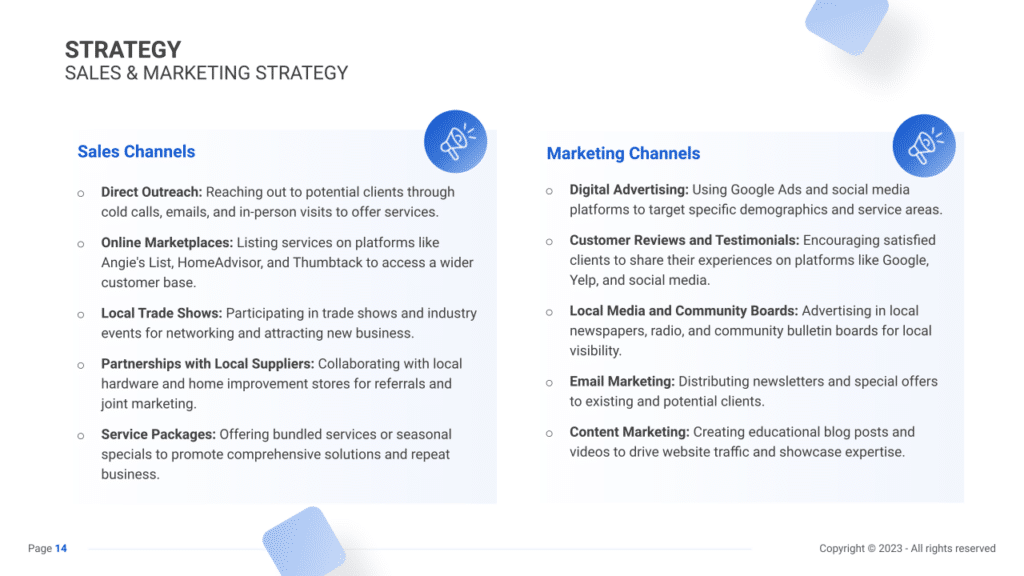
Sales Channels
Efficient sales channels are crucial for converting leads into customers:
In-Person Consultations
- Offer Comprehensive Assessments: Provide detailed consultations to understand clients’ landscaping needs and offer tailored solutions.
- Present Service Packages: Introduce different service packages or tiers that cater to various client requirements.
Online Booking and Sales
- Streamline Booking: Implement an easy-to-use online booking system on your website, allowing clients to schedule appointments at their convenience.
- E-Commerce: Sell gardening tools, plants, or landscape accessories through your website to diversify revenue streams.
Membership and Retention Programs
- Loyalty Rewards: Develop loyalty programs where clients earn points for every service availed, redeemable for discounts or additional services.
- Subscription Models: Offer subscription-based maintenance plans where clients pay a monthly fee for ongoing landscaping services, ensuring steady income and fostering client retention.
Strategy Timeline
Finally, create a detailed timeline that outlines critical milestones for the landscaping business’s launch, including initial market research, website and portfolio development, community outreach efforts, first client acquisition, and subsequent project completions. Set benchmarks for marketing initiatives, client base growth, and expansion objectives, such as offering new services or entering new markets, ensuring the business progresses with clear direction and purpose.

Management
The Management section focuses on the landscaping business’s management and their direct roles in daily operations and strategic direction. This part is crucial for understanding who is responsible for making key decisions and driving the landscaping business towards its financial and operational goals.
For your landscaping business plan, list the core team members, their specific responsibilities, and how their expertise supports the business.


Financial Plan
The Financial Plan section is a comprehensive analysis of your financial projections for revenue, expenses, and profitability. It lays out your landscaping business’s approach to securing funding, managing cash flow, and achieving breakeven.
This section typically includes detailed forecasts for the first 5 years of operation, highlighting expected revenue, operating costs and capital expenditures.
For your landscaping business plan, provide a snapshot of your financial statement (profit and loss, balance sheet, cash flow statement), as well as your key assumptions (e.g. number of customers and prices, expenses, etc.).
Make sure to cover here
_ Profit and Loss
_ Cash Flow Statement
_ Balance Sheet
_ Use of Funds






